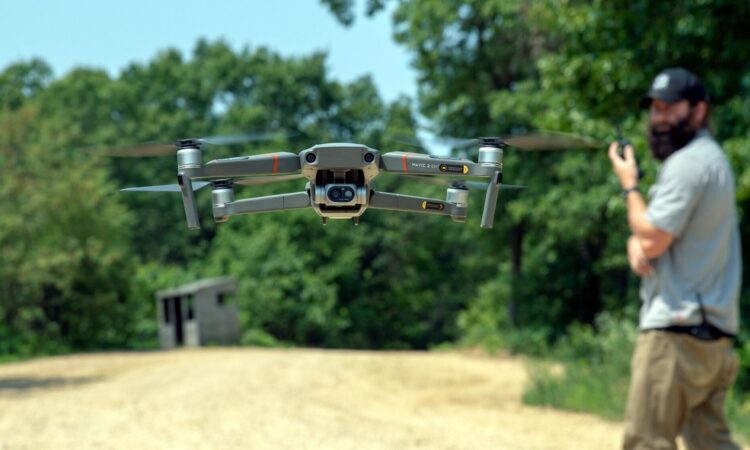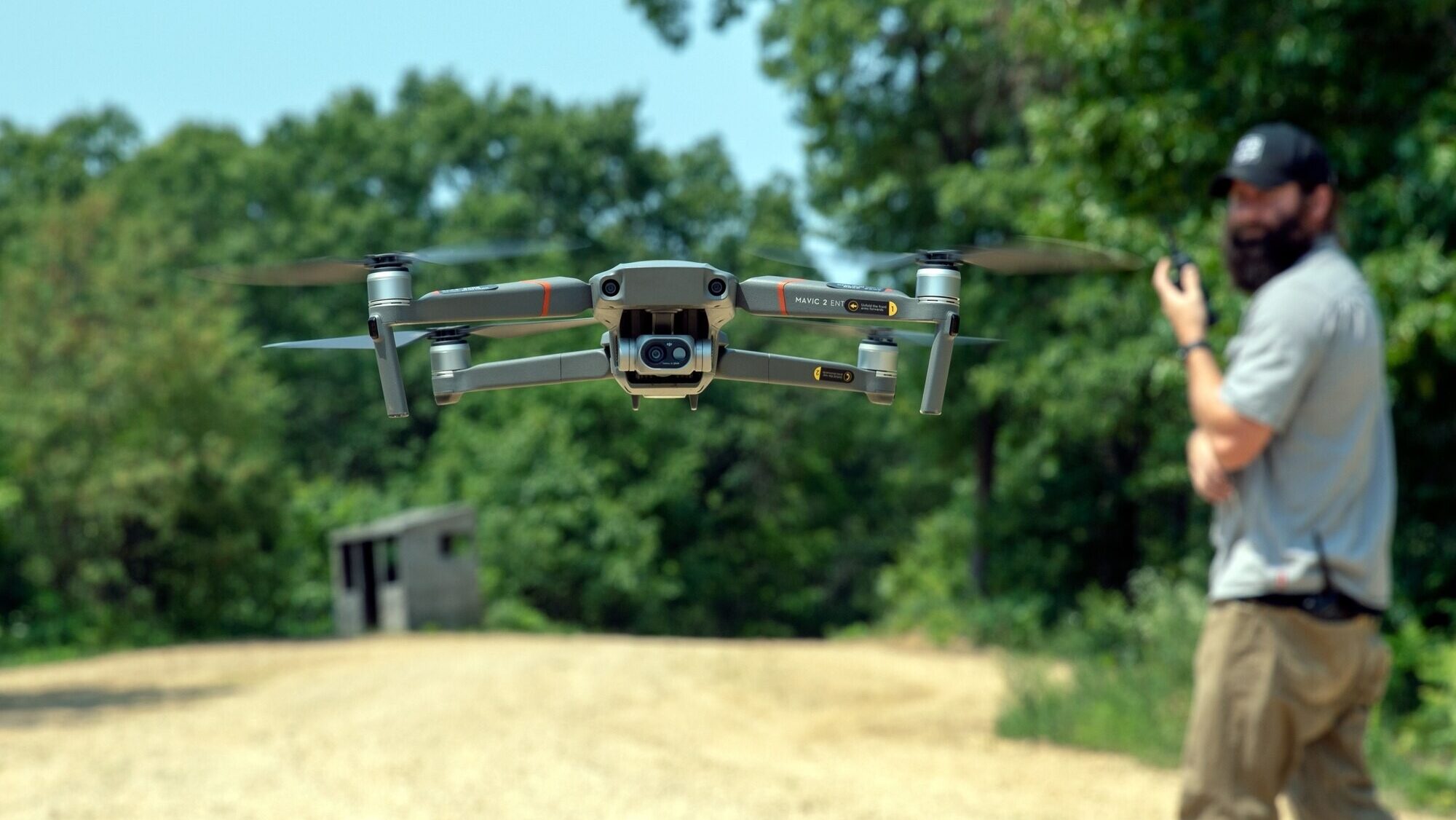
Air Warfare, All Domain, Global, Naval Warfare

A Chinese-made DJI Mavic drone lifts off to “attack” a convoy during a US Army training exercise in 2021. (Army Photo by Sgt. William A. Parsons)
WASHINGTON — In order to counter a Chinese invasion of Taiwan, the US military needs to buy a diverse fleet of uncrewed aircraft that spans the gamut from sophisticated long range stealth aircraft to cheap commercial drones, says a new report from the Center for a New American Security.
But greater US investments in drone technologies won’t be enough to erode China’s advantages, the authors of the report warn, adding that Taiwan needs to also invest heavily in its own fleet of uncrewed capabilities.
“Today, China is positioned to take advantage of its large fleet of drones, which could provide it with an edge in a war over Taiwan,” the report states. “The United States and Taiwan need to close this gap rapidly and develop a layered system of counterdrone defenses or risk being on the losing side of a war.”
The challenge for a Taiwan scenario is that China has more drones than the United States, can manufacture military drones at lower costs, and can easily bolster its fleet with a large number of cheap small drones from its commercial industrial base, the report states. Further, the US forces would face a geographic predicament that China does not: how to successfully deploy and operate drones in Taiwan from bases hundreds of miles away, and from 6,000 miles away from the continental United States.
“I don’t know if it’s going to be a fair fight,” said Stacie Pettyjohn, director of CNAS’s defense program and one of the authors of the report. “There are a lot of things that are stacked up against the United States when it’s playing an away game, like it would be in a Taiwan scenario. But I think the US can do a lot of things to level the playing field somewhat.”
The report lays out a list of recommendations for both the US military and Taiwan.
For the US, those recommendations include prioritizing the development of “good enough” long-range drones that are cheaply priced to be acquired and replaced in mass quantities. That’s sharp reversal for the Defense Department, whose current suite of long- and medium-range drones are expensive, exquisite assets like the RQ-4 Global Hawk and MQ-9 Reaper — two in-demand platforms that could provide valuable tracking and strike capabilities against China but would likely be shot down over time.
“The United States’ current slate of drones does not suit a China fight,” the report states. “The DoD must develop and procure drones with the range to perform useful missions in this theater that can be purchased in sufficient quantities to make up for the many that will inevitably be lost in combat.”
In addition, the report recommends investments in autonomous kamikaze drones that can attack Chinese ships as well as layered defensive systems that can counter Chinese drones. It also suggests the United States create a rigorous program for training drone pilots and hammer out operational concepts and tactics for using drones in the Indo-Pacific.
RELATED: US approves sale of hundreds of one way attack drones to Taiwan
The recommendations for Taiwan center on developing inexpensive small drones optimized for the close-in fight against China, such as fostering its commercial drone industrial base, investing in kamikaze drones, and figuring out how it can integrate drones with ground-based fire units. It also recommends a particular focus on maritime-based drones and cheap FPV (first person view) systems that are typically flown by hobbyists to collect video, but can be used as one-way attack drones.
The Pentagon’s Replicator initiative — which aims to field thousands of cheap uncrewed systems by 2025 — and the Air Force’s Collaborative Combat Aircraft program are positive signs that the Defense Department is willing to prioritize investments in drones, Pettyjohn said. However, in Replicator’s case, the effort doesn’t seem positioned to buy systems that are optimized for US operations in the Asia-Pacific region.
“A Switchblade 600 is a short range system,” she said, referencing theonly publicly-acknowledged systemto be purchased under Replicator’s aegis. “That would be great for Taiwan, but I’m not sure what American forces are going to do with it.”
She added that both the Replicator and CCA efforts are spearheaded by political appointees — Deputy Defense Secretary Kathleen Hicks and Air Force Secretary Frank Kendall, respectively —which could make them vulnerable to cutbacks when new leaders come in. To combat this, Pettyjohn said the Pentagon should reveal more about the investments made under the Replicator initiative to further entice venture capital investment into the US commercial drone industrial base.
“The DoD has to actually issue contracts to these companies so that they build up their production lines and invest in improving their products, knowing that they’re going to have a harder time competing on the commercial market in the short term, because [Chinese drone maker] DJI has cornered the market,” she said.
For programs like CCA, which aims to build autonomous drone wingmen to fly alongside F-35s and future stealth fighters, the Pentagon should be more creative in thinking about how it can increase performance and tamp down costs. For example, current designs are constrained by the requirement to carry certain weapons already in the US inventory. However, if new weapons were developed, perhaps CCAs could be sized and designed in a more optimized way, Pettyjohn said.
‘No Technological Silver Bullet’
The report details the recent evolution of drone warfare during the Libyan civil war in 2019-2020, the second Nagorno-Karabakh War between Azerbaijan and Armenia in 2020, and the ongoing war in Ukraine. However, Pettyjohn warned that not every outcome from those conflicts can be applied directly to a Taiwan scenario.
“I fear that there are people who are glomming on to wrong lessons, … like, ‘We just need lots of cheap drones, and that’s going to win the war for us,’” Pettyjohn said. “ I think we do need some cheap drones. But I don’t think that is, by itself a war winning capability. … There’s no technological silver bullet.”
For instance, the use of drones during the war in Ukraine has been hailed as a technological revolution, but CNAS cautions that progress on drone tech has been far more limited, incremental and dependent on legacy artillery and anti-air systems than most observers think.
“Drones provide affordable airpower, but they have not replaced traditional air forces or been able to obtain air superiority,” the report states.
The report characterizes Ukraine as a “cautionary tale,” with Ukrainian forces constantly devising new ways to use drones that are then rapidly countered by Russia, which can scale up drone production faster than Ukraine. For example, medium altitude, long endurance (MALE) drones like the Turkish-made TB-2 — which were used to great effect by Ukraine in the opening days of the war — have become largely irrelevant as more air defense systems have been fielded.
Thus, drone warfare has shifted to masses of cheap, commercially-made drones that can serve as scouts and help ground forces obtain target information. But due to the level of electronic warfare activity and number of surface-to-air missiles on the battlefield, there are high levels of losses on both sides, leading Ukraine to experiment with modified racing drones and making drones from cheap materials that are less likely to be seen via radar.
Meanwhile, while Ukraine has successfully used kamikaze drones to augment its strike capabilities, CNAS notes that those weapons still have vulnerabilities and are not fully autonomous.
“Drones complement other weapons and can partially offset capability gaps, but they have not
replaced crewed aircraft, artillery units, or missiles,” the report states.






